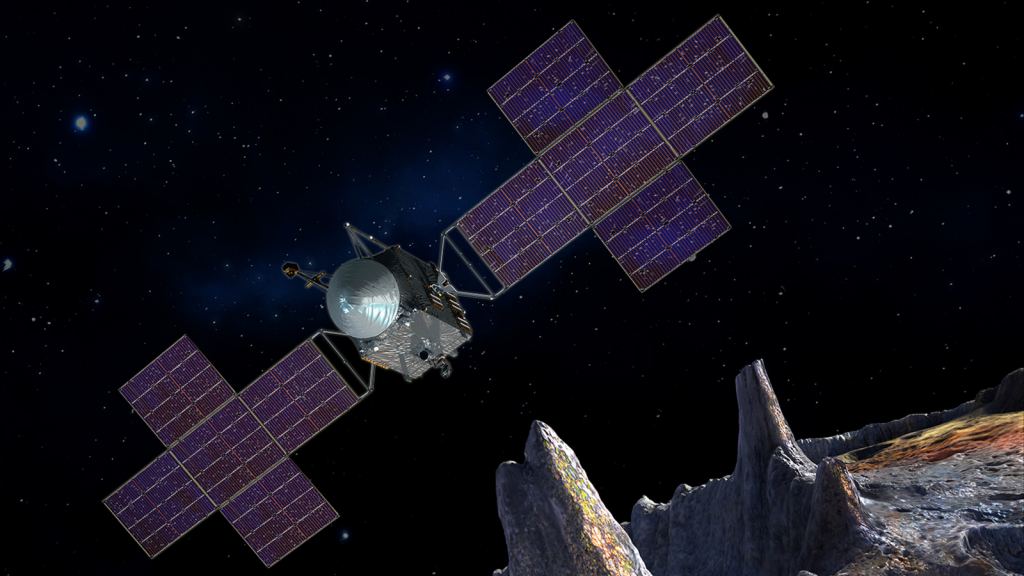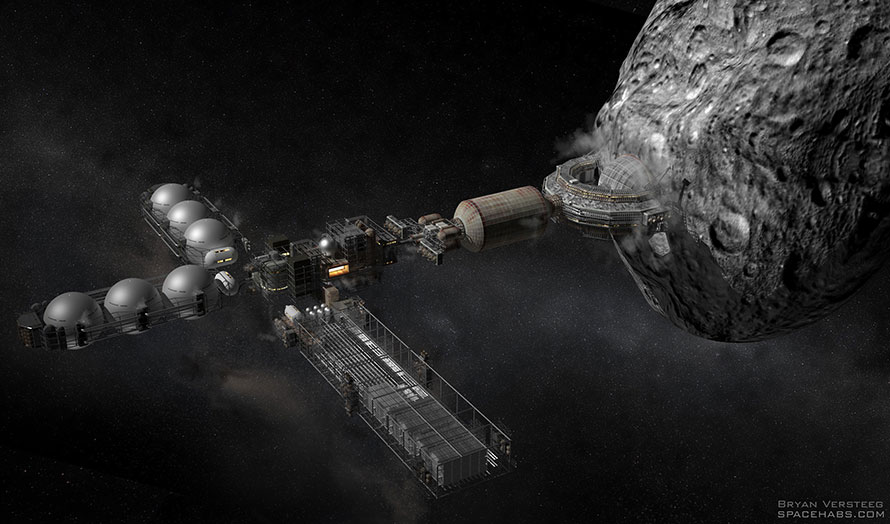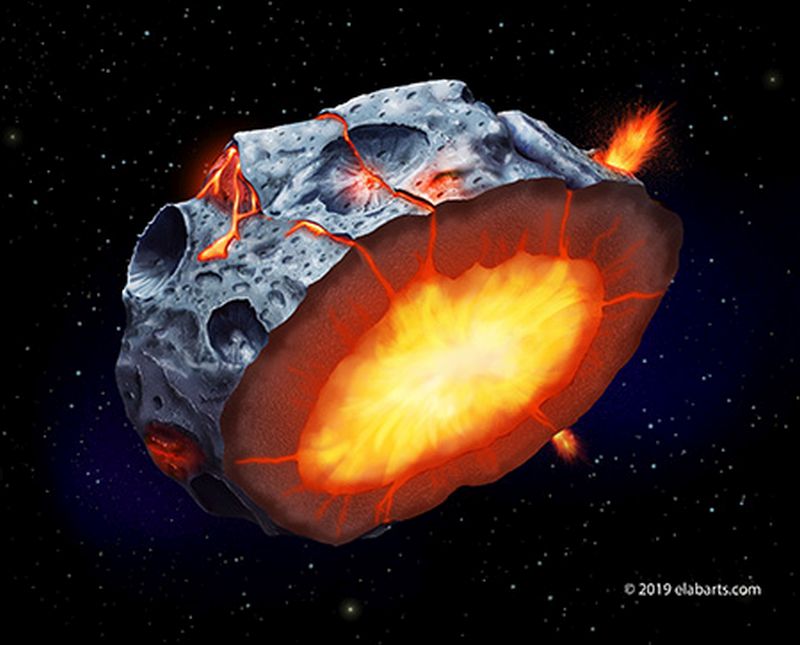It has been said that within the next quarter century, the world’s first trillionaires will emerge. It is also predicted that much of their wealth will stem from asteroid mining, a burgeoning space industry where minerals and volatile compounds will be harvested from Near-Earth Asteroids. This industry promises to flood the market with ample supplies of precious metals like gold, silver
Beyond Earth, there’s the long-term prospect of the Main Asteroid Belt, which would provide even greater abundance. This is one of the reasons why NASA’s Psyche mission to explore the metal asteroid of the same name in the Main Belt has many people excited. While the exploration of this body
What makes Psyche 16 particularly interesting is its almost pure, metallic composition. According to radar observations, the asteroid has been determined to be made up of mostly iron and nickel. This separates it from most other asteroids, which are either primarily composed of silicate minerals (S-type) or carbonaceous compounds (C-type).

And while metallic asteroids (M-type) are known to exist, Psyche is the largest of the bunch – measuring about 225 km (140 mi) in diameter. This has led many in the astronomical community to the conclusion that Psyche is actually the remnant core of a planet. Therefore, studying it would reveal a great deal about planet formation during the early Solar System and the magnetic properties of rocky worlds (like Earth).
This is why NASA hopes to send a mission to this asteroid in 2022 – which would arrive by 2026 and spend the next 21 months studying it from orbit. But for futurists and the venture capitalists, this asteroid is interesting because it contains an estimated $700 quintillion (that’s 18 zeroes!) worth of precious heavy metals, which includes vast quantities of gold and platinum.
As Scott Moore – the CEO of the Toronto-based company EuroSun Mining – recently said about the future of the industry:
“The ‘Titans of Gold’ now control hundreds of the best-producing properties around the world, but the 4-5 million ounces of gold they bring to the market every year pales in comparison to the conquests available in space.”
Granted, these kinds of missions cannot begin until all the necessary infrastructure is built. That would likely entail the creation of orbital manufacturing facilities, refueling points on or around the Moon, Mars, and in the Asteroid Belt. It would also be wise to build foundaries in the Belt or in orbit so that minerals can be processed before being brought to Earth.

For a more detailed summary, there’s Roadmap to Space Settlement (3rd ed. 2018) produced by the National Space Society (NSS). As it states in Part 5: Asteroid Mining and Orbital Space Settlements:
“Telescopic observations will initially identify asteroids as Near Earth Objects (NEO’s), Earth threatening NEOs, main belt asteroids and other orbital groupings. Initial robotic missions to NEO asteroids of commercial interest will confirm the size and composition of different types of asteroids as being rocky, metallic or carbonaceous, and identify the actual abundances of minerals on each one.”
“The probes will also estimate the structure of the asteroids, as being apparent “rubble piles” of loose fragments, or made of solid, non-fractured rock and metal. Some missions may bring back actual samples of asteroid material for analysis. All this information will assist governments in planning planetary defense against threatening NEOs and will assist mining companies to decide which asteroids to focus on.”
Once that is complete, automated mining ships can be dispatched and asteroids harvested. As for how long this would take, there are some thoughts on that as well. As Professor John Zarnecki (the President of the Royal Astronomical Society) explained in a 2018 interview with International Business Times, asteroid mining could be happening within a quarter of a century:
“The timeline for space mining is the $64,000 question. My opinion is probably 25 years for a ‘proof of concept’ set-up, and 50 years for a commercial start. But there are so many uncertainties—mostly based around economics and the progress of space technology.”

A challenge, to be sure, and one which requires a lot of time and resources. But there is no shortage of nations and private interests looking to stake out a slice of the market – one which is already established. According to estimates by Allied Market Research, the global market for asteroid mining will top $3.8 billion by 2025.
Beyond that, asteroid mining is expected to be the focal point of the next industrial “boom”. It won’t begin in the Main Asteroid Belt, but it won’t end there either. All told, this burgeoning market could eventually reach from the inner Solar System to the Kuiper Belt, harvesting everything from metals and volatiles to helium-3 and rare Earth elements.
“What we’re doing on the ground now may be impressive, but like everything else, even gold exploration in space is only a matter of infrastructure,” added Moore. “We’ll get to it, eventually… This may be the Holy Grail of space exploration for gold, but it won’t be the first stop on this adventure.”
In the meantime, the Psyche mission promises to teach us a great deal about how the rocky planets of our Solar System came to be. Understanding its magnetic properties could also reveal how Earth has managed to hold onto its protective magnetic field while planets like Mercury, Venus, and Mars have not. In Mars’ case, this led to the surface changing from a warmer, wetter environment to the cold, dry and inhospitable place it is today.
As of June 11, NASA announced that the Psyche mission had been cleared to move to Phase C of its development. This will consist of the Psyche team finalizing the system design, developing detailed plans and procedures for the spacecraft and science mission, and completing the process of assembling and testing the spacecraft and its subsystems.
Phase D, which will include the final assembly and testing of the spacecraft before launch, will begin in early 2021. If all goes according to plan, the mission is scheduled to launch by August of 2022.
Further Reading: Oil Price, ASU-Psyche, NASA


Live in the FUTURE.
It’s just starting now.
My neurons are a bit slow today. I guess I’m living in the past.
The more we find, the less precious it gets…
Such is the paradox of a post-scarcity economy. Wealth disappears, but so does poverty, because both depend on the same thing: scarcity of resources. Precious things cease to be precious, but not less useful. Consider how useful gold is as a conductive metal. Can you imagine all the copper wiring in the world being replaced with something a lot more efficient?
Here in the UK copper is also used in domestic plumbing. London is potentially, in the far future, the largest most concentrated copper deposit in the world.
Space mining. Sure to be an unregulated free-for-all with loose, if any, restrictions. Gee, I wonder if errant asteroids might be dangerous to life on Earth. Not to worry; surely today’s enlightened übermensch would self-govern themselves, and be kind and wise while maximizing shareholder return at lowest cost, just like now.
Rules! Makes one shudder at the tyranny, gosh. Just don’t let Atlas shrug near any dislodgeable materials.
The first step in asteroid prospecting is determining which NEOs are threatening to Earth and then acting accordingly. That’s what the NSS report that is cited in the article addressed. They are not planning on bringing these objects into Earth orbit. Second, no one said a thing about regulations here. But good point, that is something that can and must be ironed out before asteroid mining actually takes off.
So we have plenty of metal but we’re running out of soil. Withe the current rates of soil erosion we might not have enough to feed the world in 100 years.
It’s worth noting that the new theories on easter island show that the land originally once fertile and forrested was cleared to make way for agriculture. Over time erosion washed the soils down into the sea. There were no new minerals entering the system and over time the land became less suitable for growing crops. Social decay soon followed and there are small sad reminders of inhabitants trying to build terraces and wind breaks to capture soil. They unfortunately didn’t have anywhere to move to. Is this our planetary future?
This treasure belongs in space for space. Some scare resources that we need on the Earth, okay, thrown down the gravity well. Better to use it to build the swarm habitats and get the Earth’ human population down below a billion again. I fear I am outvoted – the billionaires have so much more votes than me with their tech to manufacture consent. Humans are evil that way.